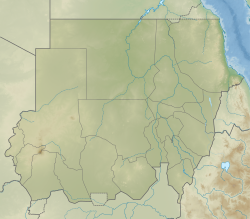| Location | Sudan |
|---|---|
| Coordinates | 16°40′12″N 33°26′59″E / 16.67°N 33.4496°E |
| History | |
| Associated with | Central Sudanese Neolithic |
| Site notes | |
| Excavation dates | 1980, 1985-1986 |
| Archaeologists | Yves Lecointe with the SFDAS |
Ghaba is a Neolithic cemetery mound and African archaeological site located in Central Sudan in the Shendi region of the Nile Valley.[1][2] The site, discovered in 1977 by the Section Française de la Direction des Antiquités du Soudan (SFDAS) while they were investigating nearby Kadada, dates to 4750–4350 and 4000–3650 cal BC.[1][2] Archaeology of the site originally heavily emphasized pottery, as there were many intact or mostly intact vessels.[1] Recent analysis has focused on study of plant material found, which indicates that Ghaba may have been domesticating cereals earlier than previously believed.[2][3] Though the site is a cemetery, little analysis has taken place on the skeletons due to circumstances of the excavation and poor preservation due to the environment. The artifacts at Ghaba suggest the people who used the cemetery were part of a regionalization separating central Sudan's Neolithic from Nubia.[1] While many traditions match with Nubia, the people represented at Ghaba had some of their own particular practices in food production and bead and pottery production, which likely occurred on a relatively small scale.[1][2][3] They also had some distinct funerary traditions, as evidenced by their grave goods. The people at Ghaba would have likely existed at least partially in a trade network that spread through the Nile and to the Red Sea.[1] They used agriculture, cultivation, and cattle for sustenance.[3]
- ^ a b c d e f S. Salvatori, D. Usai, Y. Lecointe (2016). Ghaba An Early Neolithic Cemetery in Central Sudan. Africa Magna Verlag.
{{cite book}}: CS1 maint: multiple names: authors list (link) - ^ a b c d Madella, Marco; García-Granero, Juan José; Out, Welmoed A.; Ryan, Philippa; Usai, Donatella (2014-10-22). "Microbotanical Evidence of Domestic Cereals in Africa 7000 Years Ago". PLOS ONE. 9 (10): e110177. doi:10.1371/journal.pone.0110177. ISSN 1932-6203. PMC 4206403. PMID 25338096.
- ^ a b c Cite error: The named reference
:3was invoked but never defined (see the help page).
